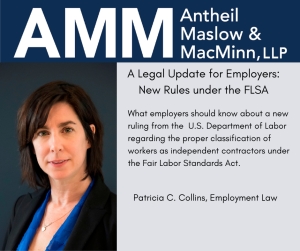The Department of Labor's New Independent Contractor Rule
Reprinted with permission from the February June 13th edition of The Legal Intelligencer. (c) 2024 ALM Media Properties. Further duplication without permission is prohibited.
On January 9, 2023, the United States Department of Labor issued a new final rule regarding the proper classification of workers as independent contractors under the Fair Labor Standards Act. While the rule is technically new, it is, in substance, a recitation of the applicable law regarding the proper classification of workers set forth by the Supreme Court.
Prior to recent rule making, caselaw guided the determination of whether a worker was an employee or independent contractor under the Fair Labor Standards Act (“FLSA”). In United States v. Silk, the United States Supreme Court outlined the factors relevant to the determination: degree of control, opportunities for profit or loss, investment in facilities, permanency of relations and skill required in the claimed independent operation. The Silk court noted that “no one factor is controlling.” Just about every court, federal or state, applies the same or similar standard to determine the issue under the FLSA or state statutes regarding minimum wage and overtime pay.
One Final Overtime Update…..
…At least until there is another overtime update.
Let’s review the history of these regulations. Prior to leaving office, President Obama’s Department of Labor significantly revised the salary requirements in order for certain classifications of employees to qualify for exemptions from overtime pay under the Fair Labor and Standards Act (“FLSA”). The DOL increased the salary minimum to qualify for an exemption from approximately $23,000 to approximately $47,000. Small employers and nonprofits scrambled to find a way to comply with the new regulations by the compliance deadline of December 1, 2016.
On November 22, 2016, the United States District Court for the Eastern District of Texas issued an injunction against the implementation of those rules. Small employers and nonprofits breathed a sigh of relief and tabled their new policies and employee classification changes.
Between November 22, 2016 and August 31, 2017, much happened in the Eastern District of Texas and the Fifth Circuit. Appeals were filed, extensions of time to file briefs were granted, and the Department of Labor, now led by President Donald Trump, revised its position on these rules. President Obama’s DOL had argued that the new regulations were a proper exercise of DOL’s rule making, and the President’s executive, powers. President Trump’s DOL argued that while the DOL and the President were within their rights to establish and revise a salary requirement, they would not defend this particular salary requirement.
On August 31, 2017, the Eastern District of Texas agreed, essentially, with the Trump DOL. The Court found that while the DOL is free to set and revise a salary requirement, this particular salary requirement was not enforceable.
The good news is that the salary requirement set by the Obama DOL was so high as to present a significant financial and operational burden for small employers and nonprofits, and this ruling eliminates that concern. However, the ruling leaves this DOL, or any DOL, free to revisit the salary requirement. In other words, we will all take this ride again sometime in the future.
Employers should continue to ensure compliance with the existing rules, and check back in with AMM for any future changes to the salary requirement.
Breaking News: Texas Federal Judge Blocks New Overtime Rules
Employers have been working to comply with new overtime rules issued by the United States Department of Labor that raise the salary level in order to meet certain exemptions from overtime rules before a December 1, 2016 deadline. Those rules require that in addition to meeting certain requirements with regard to an employee’s duties, the employee must also earn a minimum salary of $47,476. The old rule required that the employee earn a minimum salary of $23,660. The dramatic increase in the salary requirement caused employers to reevaluate classifications and to generate new policies regarding overtime and work hours.
On November 22, 2016, the United States District Court for the Eastern District of Texas issued a preliminary injunction, temporarily barring the Department of Labor from enforcing the new overtime rule. The order will remain in place pending a full hearing on the issue. While the order is temporary, as a prerequisite to entering the order, the Court was required to find that there was a substantial likelihood of success on the merits of the argument that the DOL exceeded its authority in promulgating the rule. So, there is some indication that the Court may bar enforcement of the new rules permanently.
For now, employers are temporarily relieved of the obligation to comply with the new rules by the December 1, 2016 deadline. Because the outcome is not guaranteed, employers should have their new policies ready to go, but do not need to implement them on December 1. It is simply too early to say whether employers should “shelve” those new policies. We will have to wait for the Court’s final ruling. Stay tuned to this space as the case unfolds.
Patricia Collins is an employment and litigation Partner at Antheil Maslow & MacMinn, LLP and chair of the labor and employment practice group.
Patty Collins Participates in Panel on New DOL Overtime Regulations
Patty Collins, a Partner with Antheil, Maslow & MacMinn, will be joined by Cindy Bergvall, CPA, of Bee, Bergvall & Co. for a panel discussion on new Department of Labor overtime regulations and their impact on employers. This informative breakfast seminar is hosted by The Catalyst Center for Nonprofit Management on October 7th at Aldie Mansion in Doylestown. There is no charge for this event, but registration is required.
These new regulations will require action from almost every for-profit and not-for-profit organization with employees earning less than $47, 476 per year. Participants will learn about the changes in the law and what organizations will need to do when the law goes into effect on December 1, 2016.




